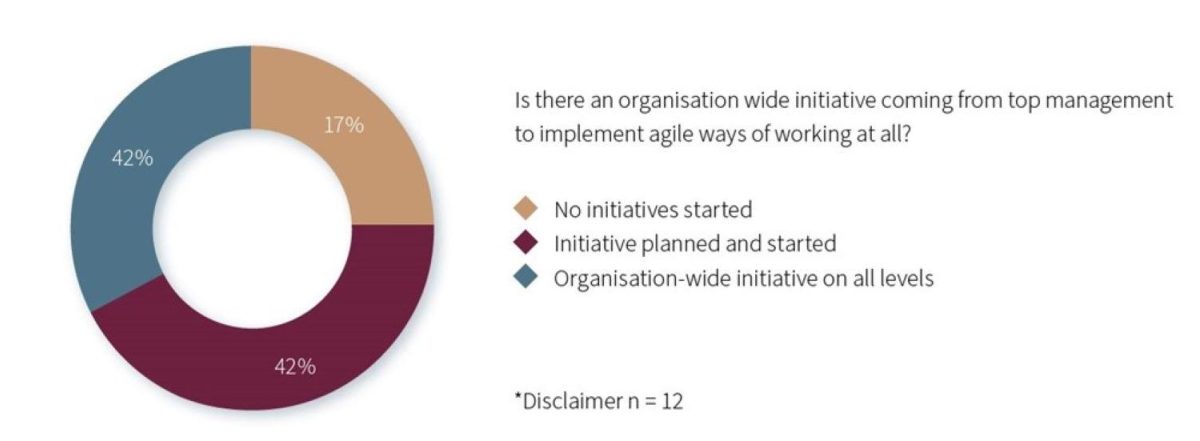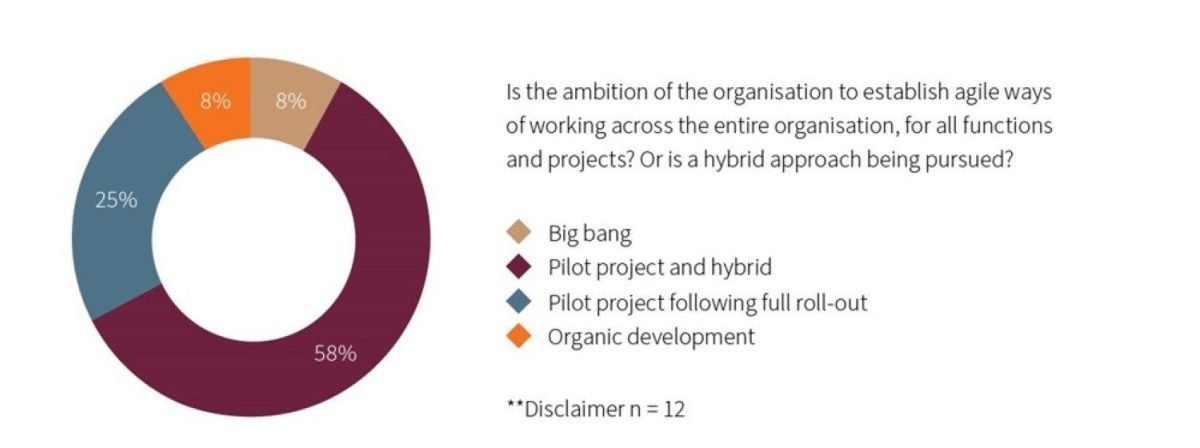This article is the third in a series of five under the main title “How Ready Are Swiss Banks to Become Organisations of the Future?”. In this chapter, we investigate how advanced Swiss banks are in adopting agile ways of working.
One aspect of organisational agility is the organisations’ way of working and delivering, be it delivering ideas, projects, or software. The benefits of agile ways of working are undisputed: higher customer focus, increased time-to-market, enhanced product quality, more empowerment, and increased transparency – all of which result in higher customer and employee satisfaction.
Whilst other industries have already transformed their entire organisation towards agile ways of working, our hypothesis is that Swiss banks still seem to be a few steps behind.
In our study, we tested this hypothesis and investigated how advanced Swiss banks are in adopting agile ways of working, and even if this is a priority at all.
How advanced are Swiss banks in adopting agile ways of working?
First, we checked whether agile ways of working are even a priority for the banks.

More than 80% of the investigated banks say agile transformation is on their strategic agenda. However, there are huge differences in how advanced they are and how they have approached an introduction of agile ways of working.

More than half of the banks have started to implement agile ways of working, rolling out pilots for selected endeavors, teams, or departments, but aim to keep both worlds at this moment in time – the agile and the traditional waterfall. Hence, they have started small by pursuing a hybrid model, with different ways of working side by side.
Only 25% have the ambition to roll out agile ways of working. Only one bank has followed a big bang approach in introducing agile ways of working, and one bank – a neobank – is following more of an “organic development”, as it is continuously adjusting ways of working since the launch of the company.
Now, how advanced are the banks really in implementing agile ways of working? We have performed a further drill down in the following areas:
- Vision and steering from top management
- Understanding of agile ways of working
- Cultural embedding
- Technical foundations
Having agile ways of working on the strategic agenda is one thing, implementing the cultural and technological change required to make them effective is another. The above series of results paint a mixed picture. Interestingly, the only one that shows any kind of clarity is the question of management vision and steering, with two participants showing strong commitment from the company's higher tiers, whilst most of the other responses cluster near the bottom of the scale. This tells us a couple of things.
One, at least some of the transformation and efforts at building agile ways of working are driven from the bottom up, as management vision is lacking some of the other measures in the survey.
Two, this is not the picture of an industry feeling an overwhelming sense of urgency, or we would see more readings on the right-hand side of the scale. Part of this is a rational response to a world where some of the old ways are still profitable – asking a company to step away from that is a heavy lift. But part of it is also displacement and certain optimistic blindness, which shows the sector, is rife for disruption. Heading off this threat is a large part of what makes the transformation we talk about necessary.
Success factors for agile ways of working
The investigated banks have mentioned the following critical success factors in their journey towards agile ways of working:
Approach
- Provide a clear vision
- Start with small but continuous and persistent steps to ensure long-term success
- Define pilots to start and learn, an early involvement of all employees is key
- Combination of bottom-up pilot (trial) approaches and top-down vision and guidance is required to ensure sustainable change
- Invest in initial awareness sessions and training for employees and management to ensure understanding of the key principles and benefits of agile ways of working
- Combine external and internal coaches to support during the initial phases
Manifestation
- Keep the overall ambition and vision on top of peoples' minds, communicate regularly
- Active change management
- Train and enable employees based on their needs
- Foster an open feedback and communication culture
- Inspect and adapt approach: learn from experiences and allow the organisation to continuously develop by allowing different approaches and trials, as well as errors
- Provide the possibility to exchange experiences and share success stories within the organisation
- Achieve a certain level of standardisation to align between pilot teams on the one hand, and teams or suppliers working in the traditional setup on the other hand
We believe that agile teams are more innovative, and, hence, more successful. Our company culture allows our people to think outside of the box and collaborate and communicate across teams and functions.
Obstacles of agile ways of working
Banks have mentioned the following challenges and pitfalls when introducing and expanding agile ways of working:
- Insufficient support and involvement of top management lead to lower drive and uncoordinated advances. With no clear vision from the top, teams don’t know what to do and why, and don’t have the power to expand the agile transformation.
- A hybrid cultural model, with both waterfall and agile ways of working, makes it challenging to completely adapt to agile practices. Falling back to “the way we have always done it” is tempting.
ORGANISATIONAL AGILITY
No need to wait for the release of Chapter 4.
Download the full white paper and get a complete view of how Swiss banks score in all aspects of organisational agility.
Conclusion
The Swiss banking sector is in flux. Many different factors are pulling in many different directions. Clients increasingly demand changes in ways of accessing and using banking services, and sometimes in the services and solutions themselves.
International concerns, regulatory ambitions, and market pressures, not to mention technological acceleration, add to a sense of unsteadiness. At the same time, the traditional ways of doing business have not quite run their course.
Many old lines of business – managed in the old ways – remain profitable. These profits might in some cases be sustainable for some time. In other cases, they hide the business' inner weakness, which provides a rich opportunity for an audacious disruptor.
Our advice is to have the ambition to go all in. Yes, a bank can do it step by step, but the sense of direction must be clear and one-way. This must be consistently communicated up and down the line, starting with the top management, which must be unequivocal in its buy-in.
The most important internal stakeholders must be persuaded early, and outside expertise can help make entrenched patterns visible and break up rigid structures. In this way, a nimble bank can be built, one that uses the wave of transformation to its advantage rather than defying it for as long as it can.
Are you a future leader? Interested to see how your bank’s scores compare to other Swiss banks? We are very pleased to be at your disposal – contact us.


